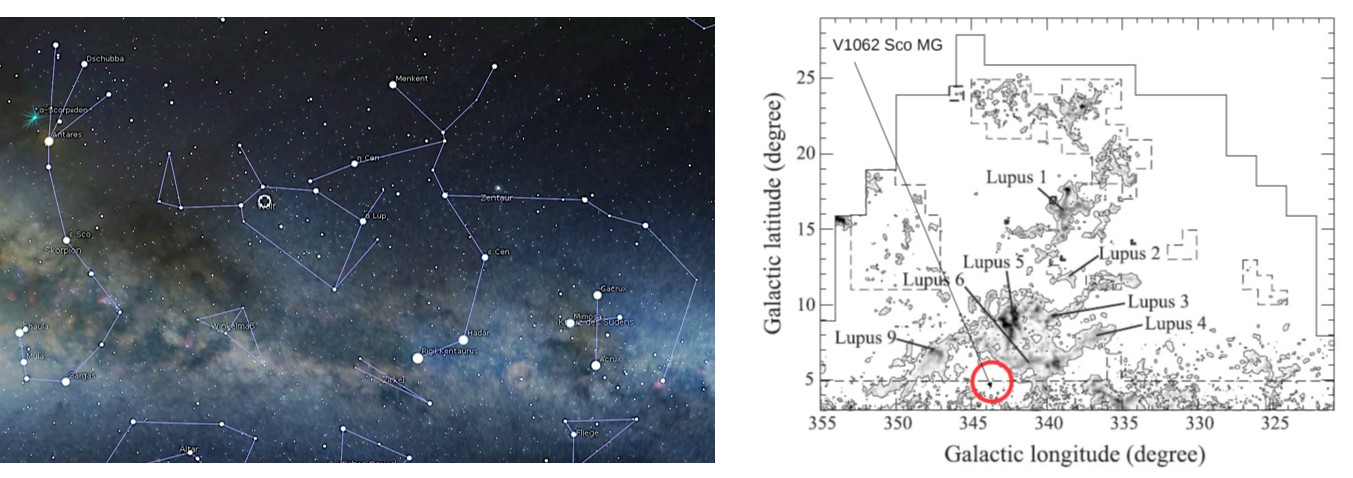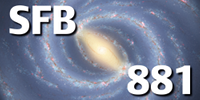New open star cluster discovered
Scientists from the Collaborative Research Centre SFB881 in Heidelberg were able to discover a previously unknown open star cluster at a distance of about 550 light-years from the sun. This discovery was made possible using observations from the Gaia satellite mission. The newly found star cluster exhibits an unusual age distribution of the involved stars.

Location of the newly discovered open star cluster V1062 Sco, on the right in front of the 12CO map from Tachihara et al. (2001). The radius of the red circle is 26 light years at a distance of 571 light years (175 parsec) from the sun, and thus roughly corresponds to the circumference of the group.
When the ESA satellite mission Gaia was launched in 2013, scientists around the world were hoping for new insights into the origins and evolution of our own galaxy and its stars. And they weren't disappointed. Already with the first publication of scientific data in 2016, the positions, movements and distances of about 2 million stars were measured much more accurately than ever before.
Scientists of the Collaborative Research Centre SFB881 "the Milky Way System" and their colleagues have now succeeded in using this data set to identify a previously unknown open cluster of stars in the vicinity of the sun.
Open star clusters are collections of stars that are gravitatively bound. It is assumed that these stars were created at the same time. Since then, they have been moving through space at the same speed. Open clusters are relatively young objects (with a typical age of 500 million years) as they dissolve sooner or later under the influence of the tidal effect of the Milky Way. "The observation of star clusters provides us therefore with an excellent insight into the birth conditions of these stars and allows us to draw conclusions about the origin and development of stars and the Milky Way disk", explains Elena Schilbach from Zentrum für Astronomie of Heidelberg University.
Using the data collected by Gaia, the scientists were now able to examine the stars in the vicinity of the sun much more precise. They encountered a hitherto unknown young cluster of stars about 550 light-years away from the sun, within the so-called Scorpius-Centaurus-Association. Only with the precise measurements of the Gaia mission it was possible to examine the speed deviations of the 63 associated stars with the necessary accuracy and therefore to recognize these stars as members of an open cluster.
The newly discovered star cluster shows several surprising properties: On the one hand, it is located in a region with rather low gas and dust density, something unusual for such a young cluster. On the other hand, the age of the associated stars varies between 4 and 25 million years. Up to now it has been assumed that star formation from a collapsing molecular cloud occurs on a very short time scale, the measured age difference of the stars speaks against this. For the authors of the study this is an intriguing result: "With the recent publication of the Gaia catalogue in April 2018, the positions and speeds of more than 1 billion stars will be determined, up to twenty times more precisely than now. If our results can be confirmed, this will shed a new light on the formation of stars in molecular clouds", explains Siegfried Röser, one of the authors of the study.
The scientists hope not only for a more precise determination of the stars in the now found open star cluster, but also for the discovery of further star clusters in the wider surroundings of the sun. In doing so, they want to get to the bottom of the still open questions about birth and evolution of the stars.
Additional Information:
The results described here were published in Röser et al., A new compact young moving group around V1062 Sco
in the journal A&A.
The SFB 881 researchers involved were
Siegfried Röser (Landesternwarte and Astronomisches Rechen-Institut, Zentrum für Astronomie at Heidelberg University),
Elena Schilbach (Landesternwarte and Astronomisches Rechen-Institut, Zentrum für Astronomie at Heidelberg University),
Bertrand Goldman (Max-Planck-Institut für Astronomie) und Thomas Henning (Max Planck Institute for Astronomy).
This work was supported by the subprojects B5 and B6 of the Collaborative Research Center (Sonderforschungsbereich) SFB 881 "The Milky Way System" at Heidelberg University. Collaborative Research Centers are long-term research projects funded by the Deutsche Forschungsgemeinschaft (DFG) for up to 12 years.
The research work of SFB 881 revolves around our own galaxy, the Milky Way, a typical spiral galaxy and hence a member of the most common class of massive galaxies in the universe. The scientists involved in the SFB investigate the origins and evolution of the Milky Way and its surroundings in order to clarify fundamental principles of galaxy formation.
The SFB 881 is located at the Zentrum für Astronomie der Universität Heidelberg (ZAH) and includes scientists from the Astronomisches Rechen-Institut (ARI), the Institute of Theoretical Astrophysics (ITA) and the Landessternwarte Königstuhl (LSW). The participating non-university research institutions are the Max Planck Institute for Astronomy (MPIA) and the Heidelberg Institute for Theoretical Studies (HITS). In addition, the Haus der Astronomie (HdA) helps to make research on the Milky Way accessible to the general public.
Kontakt:
Dr. Renate HubeleSonderforschungsbereich 881 „Das Milchstraßensystem“
Public Outreach
Tel. +49 6221 528-291
Email: hubele(at)hda-hd.de


